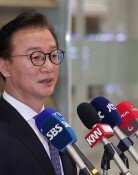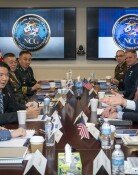Han Chul-yong and Park Seung-choon
Han Chul-yong and Park Seung-choon
Posted April. 24, 2010 06:21,
The North Korean military uses numerically encrypted codes for wireless communication. For instance, it uses 15 for attack and 2007 for Baengnyeong Island. Communicators have their own codebooks. They combine numbers cited by the caller and those in their codebooks to decrypt messages. If the caller says 1 and 20, which correspond to 5 and 7, respectively, in the recipients codebook, the codes mean, Attack Baengnyeong Island.
A unit in the South Korean military wiretaps and analyzes the Norths cryptography. On June 13 and 27, 2002, it deciphered a North Korean military message telling of an attempted attack of a point south of the Northern Limit Line, the de facto sea border between the two Koreas. The unit reported the result to the South Korean Defense Ministry but was ignored. On June 29, an inter-Korean naval clash broke out in waters off the west coast. As a result, a South Korean naval vessel sank and six crewmen were killed. South Korean Maj. Gen. Han Chul-yong disclosed how the ministry ignored the intelligence report to the National Assembly and was later discharged.
On June 12, 2004, the militaries of the two Koreas agreed to communicate in plain language using a common frequency used by international commercial vessels. About a month later, a North Korean patrol ship informed the South that a group of Chinese fishing boats were headed south, while crossing the sea border with them. One South Korean naval vessel was not deceived by this false tip, however. It warned the North Korean ship not to cross the border. When the North Korean vessel did not stop doing so, the South Korean naval ship fired warning shots to turn the intruder around.
The next day, the North sent the South a telegram protesting that the South Korean Navy opened fire on its naval ship without communicating with it. Then President Roh Moo-hyun believed the message and grew angry, ordering the military to investigate the incident. Lt. Gen. Park Seung-choon, who was in charge of military intelligence at the time, retired after spilling the beans to the media.
On Thursday, President Lee Myung-bak invited 22 retired generals to a luncheon at the presidential mansion. The lowest ranking veteran among the invitees was Ret. Maj. Gen. Han. The invitation was a sign that belatedly suggested that the presidential office acknowledged that his unit did its job. Park was not invited, but he is giving lectures on national security. Before the March 26 sinking of the naval ship Cheonan, the Souths intelligence unit had no idea of what was coming. Seoul misses commanding officers such as Han and Park, who protected the truth even under previous leftist administrations.
Editorial Writer Lee Jeong-hoon (hoon@donga.com)







